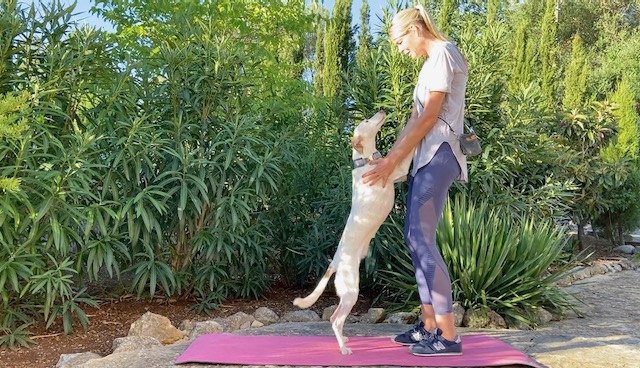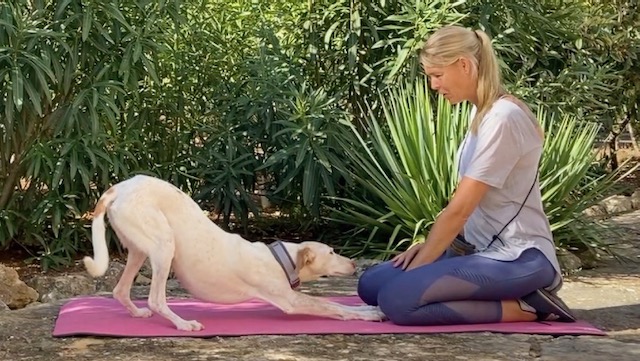Stretching exercises in dogs are not only useful in dog sports for warming up and form an important part of the warm up. At the same time, stretching can also be used to restore a dog’s mobility in the case of musculoskeletal disorders, in older dogs and after fractures. During active stretching, the muscles are stretched, but also ligaments, tendons and the joint capsule. At the same time, joint mobility is promoted. Stretching exercises dog
It can also help relieve existing muscle tension and stretch shortened muscles. Muscle tone is improved. This avoids muscular imbalances and thus prevents incorrect posture.
Stretching in dog sports as a warm up and cool down – that’s why it is so important stretching exercises dog
In addition to the described effects, stretching also leads to metabolic activation and increases blood flow to the muscles. In dog sports, stretching the muscles as part of the warm-up plays an important role in minimizing the risk of injury and increasing the dog’s performance. The mobility of the entire body increases and the coordinative performance improves. In the cool down phase, the muscles can regenerate better and faster.
When to abandon stretching in the dog
Stretching exercises should be avoided, for example, if joints are inflamed, in case of muscle injuries, tumors or swollen lymph nodes in the area to be stretched. Also, if the area to be stretched is unstable, active stretching should be avoided. Stretching exercises dog
3 exercises to stretch the body of the dog
In the following I will introduce you to various exercises for active stretching of different areas of the dog’s body. Of course, the exercises can be built up in different ways – e.g. with a clicker, with targets, marker words or treats. My heart goes out to you to please always work positively with your dog.
The important thing with active stretching is that your dog basically does the movement himself. So you should not “help” by pressing or the like. Give your dog the opportunity to work out the exercise and the movements involved. The range of motion of the trained area will gradually improve at your dog’s individual pace. Especially when areas of the body are “rusty” and mobility is limited, it takes some patience to increase it again. The way is the goal and already the structure of the exercise leads to the fact that your dog uses his body consciously.
Stretching – All cardinal points stretching exercises dog
Trained body areas
Neck, throat and back muscles
Effect
You keep muscles, tendons and ligaments of the neck and back elastic and increase your dog’s mobility. This is important because they support the spine and give stability. In addition, with this exercise you train coordination and balance.
When not
Instability and pain in the spine
How to do – structure of the exercise stretching exercises dog
Your dog is in the starting position Stand.


To encourage spinal mobility in all directions, guide a treat toward your dog’s various joints. This way you can guide a treat in both directions in a tight arc towards the shoulder or – a little lower – towards the elbow. In addition, you can guide a treat towards the front and back paws, knees, hocks and hips in each direction. Your dog should hold the position briefly each time – for about 3-5 seconds.
This is where a target can help so your dog can hold his position on the spot. By the way, your dog is welcome to lean on your legs for support.
Variation of the exercise
Some dogs are uncomfortable with you standing over them. In this case, I recommend you squat in front of or next to your standing dog and guide the treat from there. Stretching exercises dog
Tip: If your dog has mastered the nose touch, you can also use it instead of the treat to hold the position.
Stretching – Standing on the hind legs
Trained body areas
Front leg and shoulder muscles, back muscles, hind legs and croup muscles.
Effect
Standing on hind legs is an effective stretching of the muscles of the front legs as well as the shoulders, back and hips. It also strengthens the muscles of the hind legs and lower back and promotes balance and coordination of the entire body.
When not
Instability and pain in the lower back or hind legs
Here’s how – structure of the exercise
Your dog is in the start position Stand or Sit. You stand in front of your dog and you look at each other. Encourage your dog (with the help of a treat) to stand up to you. Your dog should line up against you with his front legs extended, if possible, so that the stretching effect is greatest. He should hold this position for about 3-5 seconds. Then, give your dog the signal to go back to the starting position and reward him. When your dog has understood what you want from him during the exercise, you can also gradually omit the treat and work with a sight and word signal.

If you don’t want your dog to jump up at you, you can also motivate him to stand up against a wall, tree, or similar.
Variation of the exercise
If your dog is confident with the exercise, you can also do it on a flexible surface like a balance pad or similar.
Stretching – bowing stretching exercises dog
Trained body areas
Entire body, especially muscles of hind limbs and lower back
Effect
Bowing trains the mobility of the forelimbs and thoracic spine, stretches the muscles of the forelimbs and shoulders. In addition, the deep muscles and coordination of the dog are promoted.
Here’s how – structure of the exercise
Your dog is in the starting position Stand. Your dog should now go into the low position with his front body, as if he were making a play call. To do this, pass a treat down in front of your dog’s nose towards his front legs. As soon as he bends his front legs, you reward him (you can also work with marker word/clicker here) and immediately bring the next treat back up so that he is back in the starting position.

Repeat this movement several times, gradually trying to lure your dog further down. His buttocks should remain up. When your dog performs the movement safely, you can gradually drop the treat and introduce a hand and word signal. Then reward him accordingly only after each repetition. In the bow should remain for about 5-7 seconds.
Tip: If your dog tends to go down with his bottom, you can hold a hand under his belly to help.
Variation of the exercise
When your dog is confident in the exercise, you can increase the length of time he stays in the bow.
Quality instead of quantity
As with all fitness and exercise training exercises for dogs, it is important that you take your time to build up the exercises slowly and as precisely as possible. The more precise your dog is in performing the exercise, the greater the effect. Your dog should always be given the opportunity to think along and work out the exercise. Furthermore, the exercises do not depend on the quantity but on the quality with which your dog performs them. Stretching exercises dog
Now I wish you and your dog a lot of fun trying out the exercises!
PS: If you want to know more exercises from the world of dog fitness, then I recommend my Dog Fitness Media Library! There you will find more than 50 different video tutorials with exercises around dog fitness training – muscle building, agility, coordination, stretching, isometric exercises, and much more.
All the love, your Tina
Dieser Beitrag ist auch verfügbar auf:
Français (French)
Deutsch (German)
Español (Spanish)














